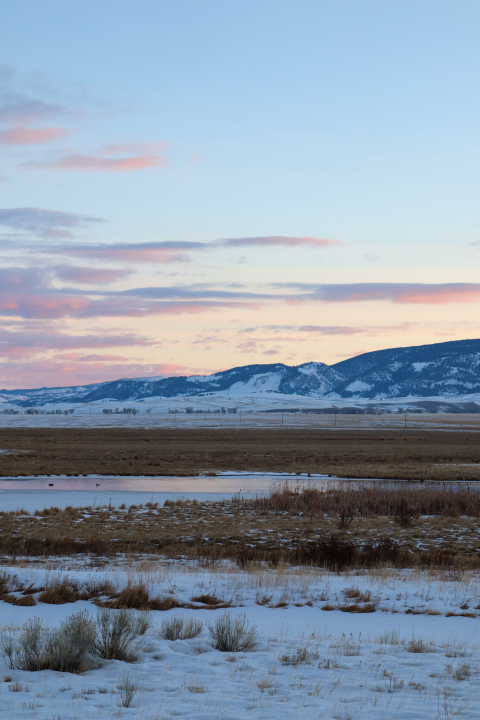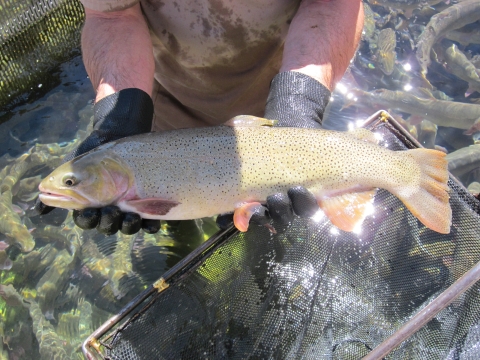About Us
The Refuge protects critically important habitat for numerous iconic species, including elk, bison, wolves, trumpeter swans, bald eagles, bighorn sheep, and cutthroat trout. The landscape of the Refuge is primarily glacial outwash plain and rolling hills with a narrow, winding river. The Refuge is surrounded by the rugged peaks of the Teton and Gros Ventre Mountain Ranges.
The Refuge was established by various Acts of Congress, executive orders, and other documents to provide, preserve, restore, and manage lands for wintering elk, birds, and other big game animals. The main Act of Congress on August 10, 1912 set aside lands “for the establishment of a winter game (elk) reserve in the State of Wyoming, lying south of the Yellowstone Park . . .”
The National Elk Refuge, along with the lands and waters of the Greater Yellowstone Ecosystem have been home to Indigenous peoples since time immemorial. Numerous Tribes consider the GYE a part of their ancestral homelands. This includes, but is not limited to, Apsáalooke/Crow, Arapaho, Cheyenne and Ute Nations, Bannock, Aaniiih/Gros Ventre, Ksanka/Kootenai, Lakota, Weyíiletpuu/Cayuse, Umatilla, Walla Walla, Lemhi, Little Shell Chippewa, Nakoda/Assiniboine, Nez Perce, Niitsitapi/Blackfeet, Ql̓ispe/Upper Pend d’Oreille, and Séliš/Bitterroot Salish.
Our Mission
Each unit of the National Wildlife Refuge System is established to serve a statutory purpose that targets the conservation of native species dependent on its lands and waters. All activities on those acres are reviewed for compatibility with this statutory purpose.
The National Elk Refuge was established in 1912 as a "winter game reserve" to support the conservation of wintering elk and their habitat. Nearly a decade later, an Executive Order passed that expanded the purpose of the Refuge to include protections for bird nesting habitat. Today, the purpose has been broadened to include conservation of fish, wildlife, natural resources, and threatened or endangered species.
Our History
Humans have occupied the landscape of the National Elk Refuge and surrounding area for 11,000 years, supporting a diverse history and varied purpose of the land and resources. For thousands of years, Indigenous peoples used the land seasonally, following herds of bison, bighorn sheep, and elk to and from summer camps.
By the turn of the 20th century, newcomers arrived in valley with the intent to make Jackson Hole a permanent residence. Rapid settlement led to land development and growing infrastructure, that disrupted historical elk migration routes and wintering areas. Reduced habitat and severe winters led to the starvation death of thousands of elk. Dismayed at the sight of dead and dying elk, the residents of Jackson Hole started a grassroots campaign to protect the elk. The public outcry from residents in Jackson Hole gained national attention. In 1912, the US Congress passed an Act designating a “winter game (elk) reserve,” establishing the National Elk Refuge.
Today the National Elk Refuge is used by humans for wildlife-dependent recreation, such as hunting, fishing, photography, wildlife observation, and interpretation and environmental education opportunities. Human use of the refuge also includes wildlife management, cultural ceremonies, habitat management, scientific research, and other public use that is determined to be compatible with the purpose of the refuge.
Other Facilities in this Complex
Jackson National Fish Hatchery
Visit the the Jackson National Fish Hatchery today! Located on the National Elk Refuge, the Hatchery has many visitor opportunities for you and your family. During your visit you can tour the fish hatchery production site, picnic near a scenic pond, and go fishing (Wyoming fishing license is required).The Hatchery is open daily from 8AM-5PM (excluding federal holidays).
The Jackson National Fish Hatchery is located 3.5 miles north of the Jackson Hole & Greater Yellowstone Visitor Center on HWY 191.






